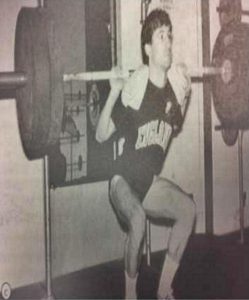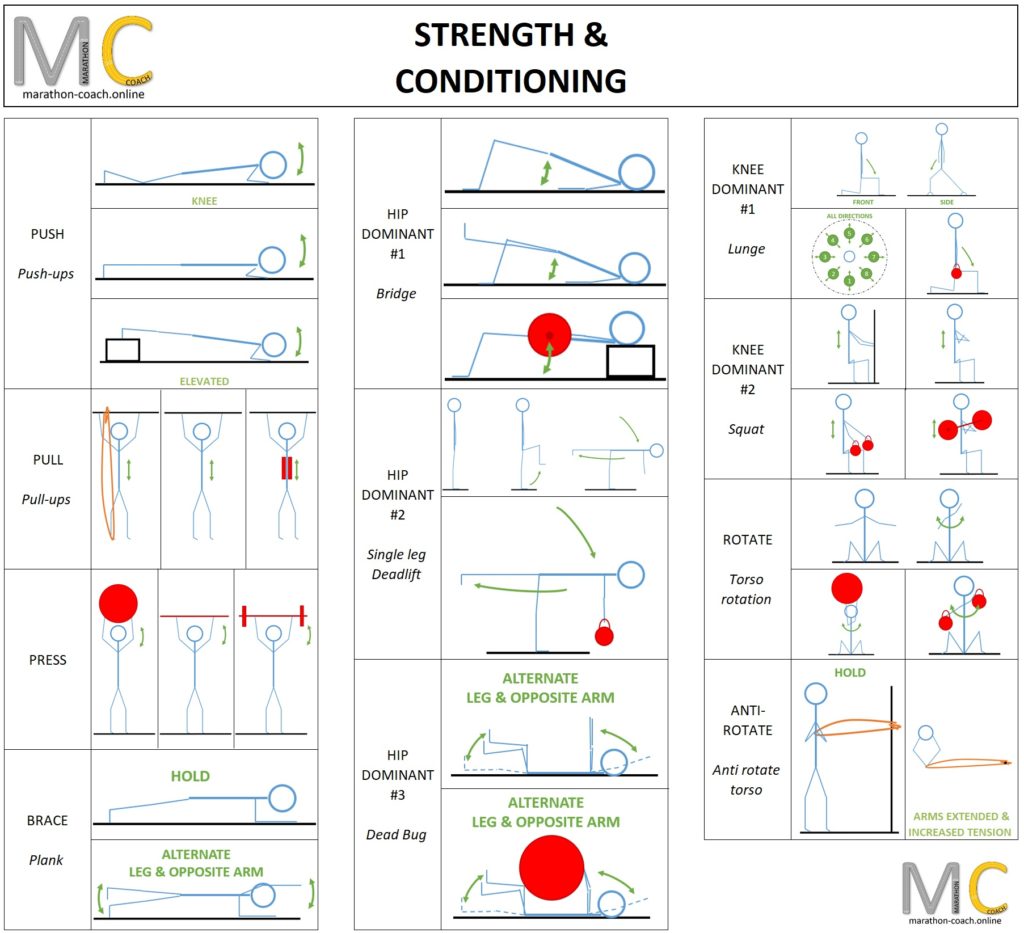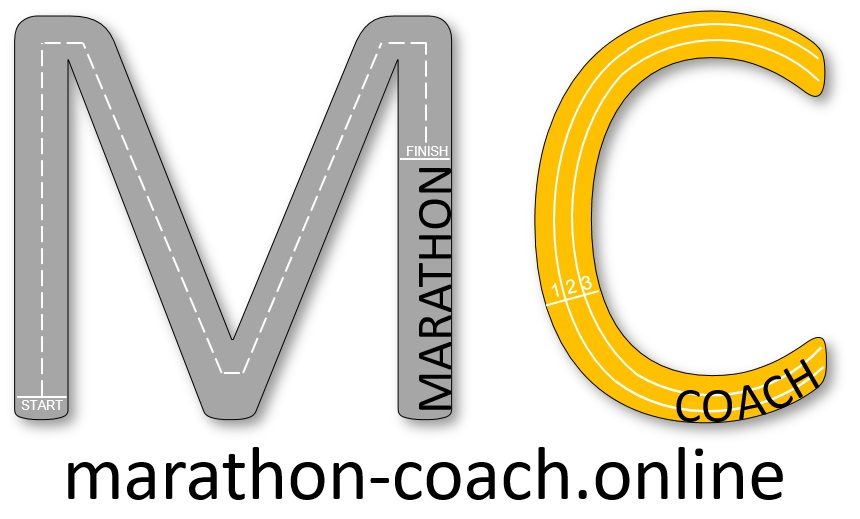Strength and Conditioning:
Strength and Conditioning is part of most professional athletes training. It is not something new. George Gandy, the coach at Loughborough University, who worked with Seb Coe, had a macrocycle from October to September with weights session on Mondays and a circuit once weekly on Wednesday evenings :

This involved 30 x 30 second stations covering the 13 exercises as shown below :

Source: Motley Health. (2018). Run a faster mile with the Loughborough Circuit.
Strength and Conditioning for runners:
Most of recreational / regional runners, don’t have much time to train due to work, family commitments. Then the training plans were dedicated to running. When somebody gets an injury, the physio will suggest exercises.
Strength and Conditioning is not part of the normal routine for an athlete.
There have been studies during the last years, confirming the running performance are improving by introducing Strength and Conditioning in the training routine.
Scientific articles:
Effects of Strength Training
Effects of Strength Training on the Physiological Determinants of Middle- and Long-Distance Running Performance: A Systematic Review
Richard C. Blagrove, Glyn Howatson, Philip R. Hayes
Published online: 16 December 2017
Key points:
“Strength training (ST) appears to provide benefits to running economy, time trial performance and maximal sprint speed in middle- and long-distance runners of all abilities.
Maximal oxygen uptake, blood lactate parameters, and body composition appear to be unaffected by the addition of ST to a distance runner’s program.
Adding ST, in the form of heavy resistance training, explosive resistance training, and plyometric training performed, on 2-3 occasions per week is likely to positively affect performance.”
Effects of Resistance training:
Effects of resistance training on neuromuscular characteristics and pacing during 10-km running time trial
Mayara V Damasceno et al
February 2015
Abstract:
“The purpose of this study was to analyze the impact of an 8-week strength training program on the neuromuscular characteristics and pacing adopted by runners during a self-paced endurance running. Eighteen endurance runners were allocated into either strength training group (STG) or control group (CG) and performed the following tests before and after the training period:
(a) incremental test
(b) running speed-constant test
(c) 10-km running time trial
(d) drop jump test
(e) 30-s Wingate anaerobic test
(f) maximum dynamic strength test.
During 1RM, the electromyographic activity was measured. In the STG, the magnitude of improvement for 1RM, drop jump, and peak treadmill speed was significantly higher compared to CG. This increase in the 1RM for STG was accompanied by a tendency to a higher electromyographic activity.
The magnitude of improvement for 10-km running performance was higher (2.5 %) for STG than for CG. Performance was improved mainly due to higher speeds during the last seven laps of the 10-km running trial. There were no significant differences between before and after training period for maximal oxygen uptake, respiratory compensation point, running economy, and anaerobic performance for both groups (P > 0.05). These findings suggest that a strength training program offers a potent stimulus to counteract fatigue during the last parts of a 10-km running race, resulting in an improved overall running performance.”
Integration in the training plan:
I think it is very important to introduce Strength and Conditioning in your training plan, and even keep it up to the main races.
Ensure you start Strength and Conditioning training with your own weight. Plan 2 sessions of 40 minutes every week for 8 weeks. You can do the exercises in a gym or at home with some limited equipment. For each set, ensure you keep your back straight and keep the correct form throughout the session. I suggest you perform the exercises in a gym with a personal trainer to ensure you keep a good form.
Start the session with a good warm-up before you integrate weights.
PUSH
Simple push ups, or dumbbells push is the first exercise. If you have not enough strength, start by putting your knees on the floor.
You can ask your strength and conditioning coach, or look at this video with the 4 steps to progress your Pushups:
PULL
Put your hand apart (roughly 50 cm). If you have not enough strength you can put an elastic band on the bar, and put it under your feet to help you. If you are not able and afraid of the height, put the bar at an height of 80 cm, and perform a horizontal pull.
Ensure your hands are wide apart and you don’t do chin-ups.
On a bench you can use dumbbells to perform your pulls.
This exercise is certainly the more challenging for endurance athletes. Our shoulder and arm muscles are very lean usually. I found this video on YouTube. It can help you to perform your first pull-up:
PRESS
This time, you are working on the shoulder strength. The position is starting with the feet on the ground, then bring the medicine ball high above your head, with straight arms. You can seat on a bench if too hard, or split the legs.
HIP DOMINANT
A simple hip extension or bridge on the floor is going to work well on your hips and core. To make the exercise more difficult, use a bench and a dumbell to make a hip thruster.
(hip thruster, hip extension, bridge)
Second exercise will be to make a single leg dead-lift. Bring first your knee up in front of you then, bring your heel back to have an horizontal body, then bring back your body vertical. If you have enough stability, keep your foot in the air.
Dead bug exercise: on your back, bring your knee and arms high. Then alternate the legs / arms extensions : extend your left leg and right hand, bring back to the middle then extend your right leg, left hand.
KNEE DOMINANT
The lunge is a great exercise to improve your knee stability. Starting with a front lunge, then doing the 4 directions (easy to do clockwise) :
– front lunge
– right side lunge
– rear lunge
– left side lunge
The second exercise is the squat. Jump few times to have the correct foot placement. Then start with no bar, just body weight. Bring your glutes as low as possible. Bring your toes out to help you go further down. Elbow should go down to tights. If you have difficulties, squat on a bench / box.
When you feel you master the movement, add weights (First with a dumbbell, then with a bar).
BRACED
Use the plank position to build your core. Try to keep the position during 30 seconds to start. If you can not keep a good form during 30 seconds, put your knees on the floor instead of the feet. It is an easier position.
When you master the plank, increase the duration, then plank with one foot and the opposite hand.
ROTATE (TORSO)
Standing, rotate your torso to the right and the left. Keep the core in control. In order to reduce the rotation of the lower limbs, seat down to make the rotation. You can seat on the floor as well, knee bent.
When you master the rotation with no weight, use a medicine ball or dumbbells to add weight. Ensure every movement is controlled.
ANTI-ROTATE (TORSO)
For this exercise, use a band that you attach to a fix point. Bring tension in the band. Stretch your arms in front of you. Keep the position for 30 seconds. If it is too hard, reduce the distance to the fix point or use a longer elastic band. Turn 180 degrees and work on your other side.
Once you master it, use a stronger elastic band.

Equipment:
Limited equipment is needed, you can find the equipment in any gym. If you want to get the tools to be able to train at home, I selected the following items (associate link):
short elastic band (rubber bands will not be ideal if you wear shorts) : warm-up, squat
Mat : warm-up, push
Bench : push, pull, press, bridge, squat
Dumbbell : push, press, squat
Door Bar : pull
Long elastic band : pull, hip extension, anti-rotate
Medicine ball : press, hip, knee, rotate
Bar & weights : hip, knee, squat
Yoga cushion for your knees : basic push
Bosu / balance board / Exercise ball : more advanced exercises
S&C Session:
If you have less time than 40 minutes, it is important that you keep a good quality for each exercise. Don’t rush them.
Here are some solutions :
– You can divide the 40 minutes in 2 sessions of 20 minutes, working different muscles in each session. It is easier to fit 20 min at lunch time for example.
– There are some exercises that combine as well 2 work outs. For example doing lunges with overhead press. You work both your PRESS and KNEE DOMINANT exercises. At the bottom of the lunge, you can even rotate the torso to add a third exercise.
Ensure you keep always a good form and ensure your exercises are using the full range of motion.
Once you complete these 8 weeks, you should see a great improvement in your running form, on how you control the strides. Based on the studies, you should have improved your 10 km time as well.
The next step is to continue to improve, increase the load (adding weights (eg 5kg, 10kg or even more), changing the legs position, using medecine ball, using bands with more resistance… ), and keep the S&C sessions during the full season.
Important note:
Your main sport is running, always remember that your high training load is running, then no need to train your endurance during the S&C sessions. Concentrate on the resistance / load on the muscles.

